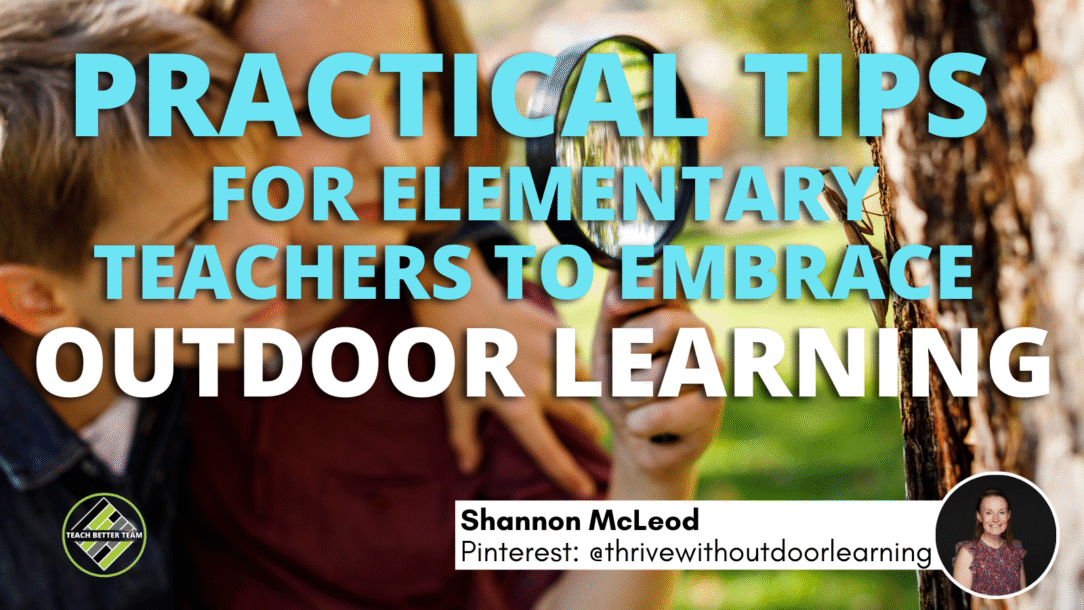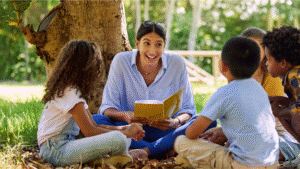There’s something magical about getting back into your classroom—fresh supplies, excited energy, and a sense of possibility. But what if this year, instead of keeping your students in a classroom filled with bulletin boards and fluorescent lights, you introduced them to blue skies and birdsong?
As an elementary teacher with over 17 years in the classroom and the founder of Thrive With Outdoor Learning, I’ve seen firsthand how stepping outside can transform classroom culture, spark student engagement, and support social-emotional development—especially at the beginning of the year.
Outdoor learning isn’t just an enrichment activity or something “extra” that you need to add in to your day. It can be a powerful foundation for a calm, connected, and curious start to the school year.
Why Move the School Year Outdoors?
School is all about relationship building, routines, and helping students feel safe and seen. Outdoor learning is a natural fit for this.
- It fosters connection. Students are more likely to collaborate, talk, and move freely in open spaces. When students are outdoors, they not only connect to each other, but they also begin connecting to their outdoor learning space. This is the first step in creating a love of nature.
- It supports regulation. Being outdoors can ease anxiety, increase focus, and help students settle into school rhythms—especially after a long summer. Students naturally relax and feel a sense of calm outdoors.
- It fuels curiosity. A single stick, ant trail, or changing leaf can spark questions and wonder, making it easy to launch inquiry-based learning. You can easily tie your literacy, math, science, art (or really any subject) to the things your students discover in nature.
- It levels the playing field. Outdoor spaces remove many of the barriers students may face indoors and invite a wide range of learning styles. Many of our learners who experience challenges in the classroom are able to thrive outdoors. Nature is a space for everyone, including our students with different abilities.
When we get our students outside, we build a strong, grounded foundation—literally and figuratively—for everything that follows.
[scroll down to keep reading]5 Practical Ideas to Get Started with Outdoor Learning
You don’t need a forest, fancy gear, or a whole new curriculum to start outdoors. Here are five simple ways to bring your classroom outside:
1. Welcome Circle Outside
Instead of gathering on the carpet, hold your morning meeting on the grass or in a natural space. Use this time to build a sense of belonging with a read-aloud, a get-to-know-you question, or a movement-based greeting. Starting your day outside also helps to eliminate a tricky transition for some students and helps ease them into the day.
2. Scavenger Hunt for Classroom Norms
Create a nature-based scavenger hunt where each item connects to a classroom expectation. For example, “Find something fragile” opens a conversation about kindness. “Find something that stands tall” invites a discussion about confidence or leadership. This tangible, hands-one activity allows students to internalize the classroom norms and expectations.
3. Outdoor Icebreakers and Name Games
Simple name games with movement—like “Name Toss” with a ball —are more energizing and inclusive when done outside. Open space allows kids to be themselves without the constraints of desks or walls.
4. Nature Journals
Give each student a notebook to sketch or write about what they observe outside. Even young learners can draw what they see and describe it with words or labels. Nature journals are a great way to ease into literacy routines while practicing mindfulness and observation. Additionally, journaling also helps students to understand that the outdoors is not just a place to play, but also a place to learn and work.
5. Create an Outdoor Classroom Map
Invite students to explore your school grounds and co-create a map of “learning spots” you’ll use throughout the year. This turns a walk into a meaningful ownership-building activity and signals that learning happens everywhere.
New to Outdoor Learning? Here’s How to Start with Confidence
You don’t have to be outdoorsy to take your class outside. You just need a willingness to try. Here are a few tips:
- Start small. One short activity outdoors per week is a great beginning. Once your students start to feel more comfortable and confident outdoors you can build on.
- Be consistent. Let students know when and why you’re heading outside so it becomes part of your routine.
- Set expectations. Practice lining up, sitting, moving safely, and using quiet voices outdoors, just like indoors.
- Be prepared. A bin of clipboards, pencils, and simple tools makes it easy to transition outside without fuss. Extra transitions or time spent waiting can create unnecesarily classroom management struggles.
- Talk to families early. Let caregivers know you’ll be learning outdoors and what clothing will help their child participate comfortably. Provide options for families who may be new to your area or be unable to afford outdoor clothing.
Remember, the goal isn’t perfection—it’s presence. Every moment you spend learning outside is a win. Additionally, nature also creates her own learning opportunities. Don’t be surprised if unanticipated learning opportunities emerge as you are outdoors.
Now Let’s Take Learning Outside..
Engaging students with outdoor learning invites them to be curious, calm, and connected. It sets a tone of trust, flexibility, and joy that carries into the months ahead. Outdoor learning creates so many beautiful and unique learning opportunities. However, you will never be able to experience these activities unless you take learning outside. Make this your year to get outside and thrive with your students.
The classroom might have four walls—but your teaching doesn’t have to.
About Shannon McLeod
Shannon is a regular classroom teacher who discovered the joy and excitement of outdoor learning early in her career. She has a passion for helping other teachers, even those who don’t consider themselves to be “outdoorsy,” take learning outside.
Over the past 15 years, Shannon has taught everything from kindergarten to 8th grade in a rural school setting. In each of her teaching positions, Shannon has found ways to adapt the curriculum for outdoor learning. Through taking her students outside on a regular basis, Shannon has seen both the amazing holistic health benefits as well as the academic benefits of outdoor learning in her students.
When she is not teaching, Shannon enjoys spending time with her husband, daughter, and their rescue dog, Vance. They enjoy hiking, canoeing, skiing, and going on adventures together.





